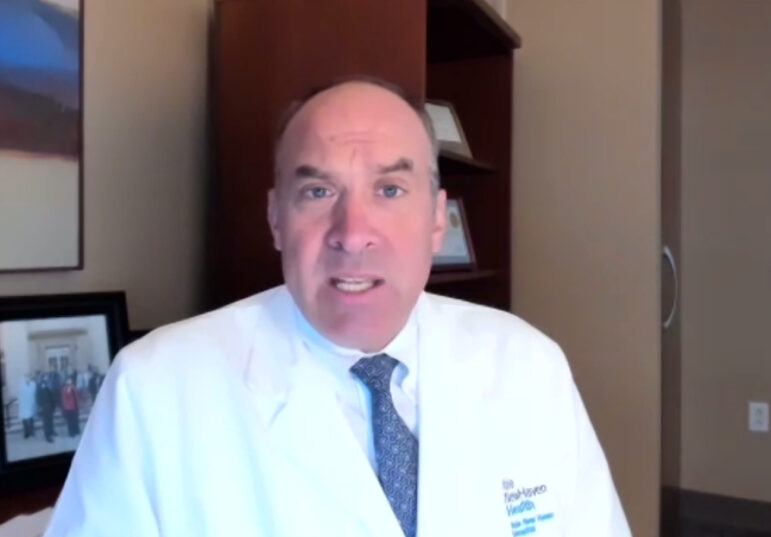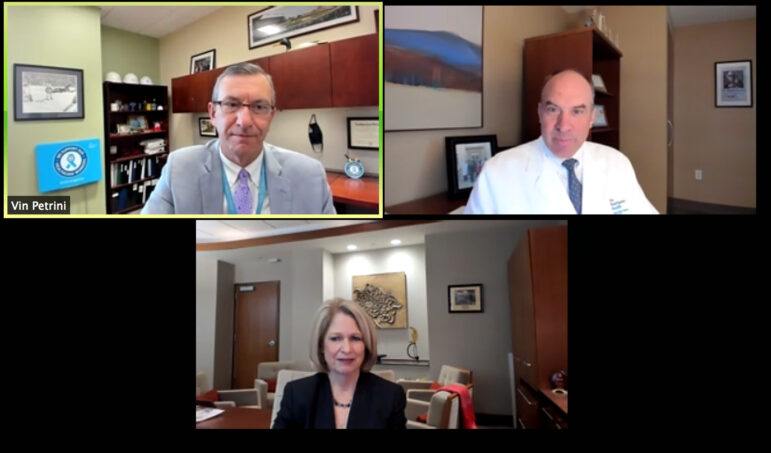Leaders of the Yale New Haven Health System – president Marna Borgstrom and chief medical officer Tom Balcezak – gave a Covid-19 Zoom press conference Wednesday and answered questions about the virus, testing delays in other parts of the country, the possibility of pool testing, potential vaccines, and the financial impacts to Connecticut hospitals.
Dr. Balcezak said Yale New Haven health tests their asymptomatic workers when they travel back to Connecticut from any of the states where travelers are required to quarantine for 14 days.
On Tuesday Governor Ned Lamont announced that four states were added to Connecticut travel advisory: Minnesota, New Mexico, Ohio, Wisconsin, and one was removed, Delaware.
Anyone traveling to Connecticut from the following states must quarantine for 14 days: Alabama, Arizona, California, Florida, Georgia, Iowa, Indiana, Kansas, Louisiana, Minnesota, Mississippi, North Carolina, New Mexico, Nevada, Ohio, Oklahoma, South Carolina, Tennessee, Texas, Utah and Wisconsin.
Balcezak said the health system is not dependent upon any outside lab as they have their own laboratories and test patients before they come in for procedures. They have been supporting the State by doing testing at area nursing homes and assisted living facilities.
The system compared two sets of tests for interesting results.
The health system tested 12,000 of their asymptomatic medical staff just before July 4 weekend and found .24% – fewer than 20 people – tested positive.
“That’s an incredibly low number,” he said. (They staff were sent home and isolated.)
The system also tested over 25,000 asymptomatic patients before they came in for procedures, finding .7% tested positive. That is more than double the percentage found in the health system employees tested.
“The virus can persist in people’s noses and in their nasal pharynx for many weeks after they have had the disease,” he said, adding that although these people may not be infectious, their procedures are being delayed until they are isolated and asymptomatic for 14 days.

Balcezak said that like difficulty accessing PPE earlier in the pandemic, the challenges around testing involve the supply chain.
“Everything from the swabs that go into the person’s nose when they get tested, to the transport media the swabs get put into when they’re brought to the lab, to the equipment in the laboratory and the kits from all the different manufacturers,” he said. “Every single one of those elements requires something that is produced in a factory and transported to us.”
The health system uses six different major commercial manufacturers simultaneously and does about 2,000 tests a day, or 10,000 a week in their own laboratories.
Borgstrom said turnaround time is still within a matter of hours.
She described herself as apolitical, but she gave the Governor a “shout out.”
“When we have asked them to intercede on our behalf with these suppliers, the Governor has not been hesitant to get on the phone with a CEO,” she said, adding, “The federal government has not taken any steps to deal with the supply issue for testing. …We don’t have a federal policy on this. It’s been left to the states. My opinion is that that is making it more difficult.”
Borgstrom said she’d spoken to colleagues across the country who are dealing with shortage of testing supplies and staffing shortages.
“They’re really in hand-to-hand combat on a daily basis to meet this pressing demand,” she said, adding that there are backlogs at Quest and other national labs causing delays in test results.
Balcezak said when asymptomatic people have to wait 7-10 days for test results they should be isolating themselves or they’re potentially spreading the virus.
“If it takes 10 days for you get the test back it’s an enormous hardship, and it’s a waste if they don’t have the disease and they’ve isolated themselves for no reason. It’s a tremendous burden, and people are going to break quarantine in certain circumstances. The more rapidly we can tell them definitively, we can reduce the spread.”
Yale New Haven Health System seeks to conduct pool testing as the burden of the disease goes down in Connecticut.
“That’s where we would take four people’s samples, put them in a single test, and if they were negative, then all four people are negative,” he explained. “But if they’re positive we’d have to do four individual tests.”
Balcezak said if the health system could do pool testing on a large scale it would have a multiplier effect on spreading out the number of individuals tested. “It works best when incidents are low,” he said.

Dr. Balcezek said the New England Journal of Medicine reported on a promising vaccine trial conducted by Moderna, who injected 45 patients back in March. Every single one of the 45 people had an antibody response.
“I hope that is a ray of light,” Balcezak said, adding that the health system is partnering with individuals to do vaccine trials in coming weeks.
Asked about the financial impacts to the health system, Borgstrom said, “We spent a lot of money on PPE. We spent a lot of money making sure members of our staff could work from home. We spent a lot of money getting negative pressure rooms ready, and increasing intensive care capacity and converting units to take care of patients.”
In addition, she said normal revenue was not coming in for elective surgeries or elective procedures or even some urgent procedures.
“It’s going to take a while to recover. This is concerning the state government because it’s not good for the Connecticut’s recovery. When we have so much uncertainty in a field like health care that’s been part of a healthy economy.”
Dr. Balcezak said Connecticut has a lot to be proud of, in terms of the reduced numbers of cases.
“It’s a product of every citizens’ hard work,” he said. “It is working. The successes we’ve seen must be sustained if we want to continue to see reduced numbers of cases.”
He said the medical community has learned a great deal about the virus, but much remains unknown.
“The virus enters the body through the respiratory tract. That’s It’s established and is fact,” he said. “The crazy thing is it attacks the cells directly, whether in your respirator tract, your kidneys, your vasculature, etc, but it also triggers an immense immune response in certain individuals,” he said. “We don’t know all the factors that make those individuals susceptible, but it causes some of the coagulation, and causes more severe symptoms we’re seeing in older patients. “
He said the virus is causing some of the symptoms seen in children.
“The MIS-C, Multisystem Inflammatory Syndrome in children, is being driven by the immune response children are having to the virus,” Balcezak explained. “It’s triggered by the virus, but the virus itself isn’t causing the damage. It’s the body’s response that causes the damage.”
He said two drugs have been found effective – both Remdesivir and dexamethasone steroid. The drugs partly treat the immune response and partly the virus itself.
He said it remains unknown why some individuals have the inflammatory response or why people react differently to the virus.
Balcezak said Yale new Haven Health was selected as a trial site for Remdesivir before it was approved by the FDA, and since then they have been getting an adequate supply.
“Gilead is ramping production and continuing distribution to each state. Now we have very little need for Remdesivir,” he said.
The Connecticut Hospital Association said that hospitals statewide incurred $2 billion in losses, and some hospitals have furloughed staff or had layoffs.
“We project, we will lose money at Yale New Haven Health this year,” Borgstrom said. “we are not an investor owned business. We do not have a profit at the end of the year that we distribute to shareholders, but we need revenue over expense to keep the basic mission of the business going.”
“Our staff stepped up to the plate,” she said, adding, “Never say never. But we don’t want to do any layoffs or furloughs. That’s nowhere in our planning right now.”
Asked about mask wearing for people returning to work, Balcezak said to use common sense. “Masks work, distance works, air circulation outside works. Put all three together and that will help prevent people from getting this disease and coming in contact with people with the disease. If you’re coming back to work, any sort of physical barriers you can put between you and someone else are good.”
“If you are in an office by yourself, you don’t need a mask,” he continued. “If someone comes into your office, you probably should wear a mask. There’s no hard and fast rules, but if you’re within six ft you should wear a mask. Touching things in common – do hand hygiene. Keep maximum distance between one another. If you can video conference, do it.”